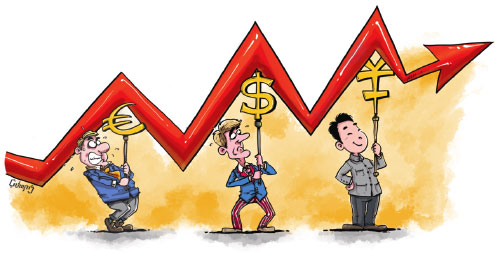
In the 35 years since China's transition to a market economy began, the country has grown at an average rate of 9.8 percent - an explosive and unprecedented rise. But there are signs that the Chinese miracle is coming to an end - or at least that the country's economic growth is slowing. China's growth rate has been falling since the first quarter of 2010. In the third quarter of 2014, it was a relatively anemic 7.3 percent.
As 2014 winds down, China's economic growth is likely to continue to face stiff headwinds, at least when compared to previous decades. As policymakers in 2015 draw up the country's 13th Five-Year Plan (2016-20), they will grapple with a fundamental question: How fast can China expect to grow?
In setting a country's GDP target, the first thing to understand is the economy's potential growth rate: the maximum pace of expansion that can be attained, assuming favorable conditions, internally and externally, without endangering the stability and sustainability of future growth. As Adam Smith discussed in An Inquiry into the Nature and Causes of the Wealth of Nations, economic growth depends on improvements in labor productivity, which today result from either technological innovation or industrial upgrading.

But developed countries at the innovation frontier are at a disadvantage. To benefit from new technology, they must create it. Developing countries, by contrast, possess a "latecomer advantage", because they can achieve technological advances through imitation, importation, integration, and licensing. As a result, their costs and risks are lower. Over the last 150 years, developed economies have grown at an average rate of 3 percent per year, whereas some developing countries have achieved annual growth rates of 7 percent or higher for periods of 20 years or longer.
To calculate how much of a latecomer advantage China has after 35 years of unprecedented growth, one needs to look at the gap between its levels of technological and industrial development and those of high-income countries. The best way to see this is by comparing its per capita income, adjusted for purchasing power parity with those of developed countries: The larger the gap in per capita income the larger the latecomer advantage and the greater the potential for growth.
In 2008, China's per capita income was just over one-fifth that of the United States. This gap is roughly equal to the gap between the US and Japan in 1951, after which Japan grew at an average annual rate of 9.2 percent for the next 20 years, or between the US and South Korea in 1977, after which South Korea grew at 7.6 percent per year for two decades. Singapore in 1967 had similar gaps - followed by similar growth rates. By extension, in the 20 years after 2008, China should have a potential growth rate of roughly 8 percent.